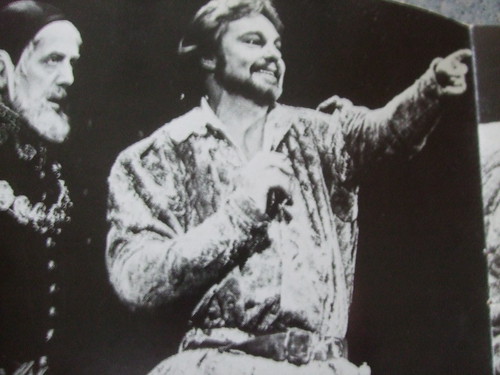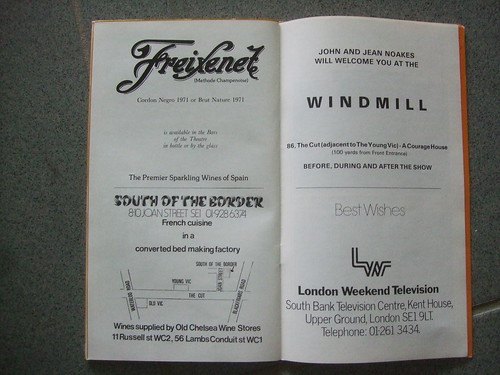 Hamlet played by David Tennant.
Directed by Gregory Doran.
Hamlet played by David Tennant.
Directed by Gregory Doran.
When I first heard about this production, I almost exploded. Already some way into this project, the idea that the then star of
my favourite franchise would be appearing in my first or second favourite Shakespeare play (yes, still osculating with Measure for Measure) was almost too heady to contemplate. Yet somehow, because of this and that, fear and finances, I missed David Tennant tramping about the Courtyard stage, and regretted it ever since. So when it was announced that the production would be filmed for the BBC, I was elated, yet
still because of the usual family related responsibilities on Boxing Day and then realising that I’d like to see it first on blu-ray (it sparkles!) that I only finally sat before it yesterday afternoon. As expected, I squeed. A lot. Do not expect this to be a deep textual analysis. If you'd like to read a deep textual analysis,
there's a very good one here.
I do at least have a programme for the stage production. When
I visited Stratford last year, the wonderful staff at the RSC made a special arrangement to have one delivered to the venue within a couple of days for me to buy so that I didn’t have to mess about with mail order. It’s a wonderful thing; I read the booklet just before watching the blu-ray and though it obviously wasn’t a substitute for the real theatrical experience, it certainly helped to increase my anticipation if not participation. In a change from what seems like the usual format of short essays about various aspects of the play, this is has a production scrapbook (
now available for download) which outlines the work of the director and the various production department such as costume and stage management.
Apparently, to help her get into character, director Gregory Doran took actress Mariah Gale to the spot in Stratford where in 1579 a girl called Katherine Hamlet died in similar circumstances to Ophelia. They found that no girl attempting to pick flowers at that river bank could leave without having been scraped and being covered cuts and bruises. Her dress would be dirty. Which is why in the production Gale looks as though she’s been through a war. Similarly we discover that even with the understudy process, the play can’t be interpreted and rehearsed twice and since one actor can’t mimic the work of another, it’s not simply the person stepping up – as Edward Bennett did when Tennant hurt himself during the West End run -- who’s flying by the seat of their pants. The rest of the company must react on the hoof to the changes being wrought.
But to the point: Tennant is extraordinary, the reviews did not overplay his achievement. It is impossible for me to watch this consummation without five years of his performance in
Doctor Who jangling about my head and indeed, it’s my impression that his approach to extrapolating Hamlet’s feigned madness is to tap into his Doctorish tendencies, the gurning, the rapid diction, his entire physical presence springing and elasticising about the rest of the household, rubbing the back of his neck as he offers a long drawn out thoughtful “Weeeelll…”, his accent almost but not quite the same as the terrestrial John Smith figure the timelord became in the story
Human Nature. This was photographed just weeks after he left his role as the timelord (June 2009), and its perhaps fitting given the context that the ghost of the tenth Doctors still hangs in the air.
Arguably he is even more compelling during those moments when these tendencies are in check, when the sober version of the character is to the fore. This is most clearly apparent in the opening wake as we see the weight of his father’s death across his sagging shoulders and right through to the apparition’s appearance. There follows a compellingly lucid moment, as he addresses us through the lense, his eyes piercing like a sword, when we watch him first take the decision to become “mad” and then after a jump cut change his entire attitude. He, if you’ll pardon the expression, regenerates.
To an extent, Tennant is so strong, he threatens to overpower everything else. This might have been less likely on stage (especially at the Courtyard were actors are easily obscured) and whilst I’m willing to admit that it could simply be caused by this fanboy’s obsession, a huge percentage of Gregory Doran’s “film” (this was shot with digital cameras) is in close-up and does seem to favour Tennant above the other actors. Despite its three hour running time, this Hamlet is by no means an ensemble piece. The prince seems to spend to time at all in England with no mention of pirates, no letter sent home, which curtails Horatio’s part somewhat (he is indeed more like Hamlet’s “companion” than in independent figure).
None of which should be seen as a criticism – perhaps aware that the star power will be bringing in an audience less aware of the play’s intricacies, Doran’s has rightly decided to keep the story relatively linear. His Frankenstein-like text is mainly F, but as is the fashion, some of the structuring, notable the placement of “To Be or Not To Be” favours Q1. Fortinbras was apparently originally cut when he was preparing the original stage script yet was reinstated during rehearsals because the actors believe that the play works best with this extra political angle. Nevertheless, that presence is still minimal on-screen; we are gifted with the meeting between Hamlet and Fortinbras’s Captain from Q2 (and the ensuing soliloquy) however he’s missing from the finale which chooses to cut away just before the Norwegian prince storms Elsinore.
Doran has also decided to enunciate Claudius’s "reconciliatory" speech about how the “common theme / Is death of fathers”. Patrick Stewart plays both Hamlet Snr and Claudius, the former retaining a very real, very physical presence in the murder exposition. Oliver Ford Davies’s Polonius is permitted to dominate the first half of the running time. He's clearly loved and shares a good relationship with his children, who complete his authoritative advice for Laertes, having probably heard it already dozens of times. Even in the scenes were Claudius appears, when Tennant isn’t in the ascendancy, Davies’s deft performance has the focus in a way which I’ve rarely seen before.
Until he’s shot. Then Stewart’s Claudius emerges and it becomes immediately apparent through the crook in the actor's lips, that the new king is of the kind to sit back and watch a game play out amongst his subjects. From the opening scenes of the play, Doran cuts away to footage of the action from he perspective of a CCtv camera – he’s very interested in surveillance culture and that was demonstrated by a set of two way mirrors in the stage production (perhaps influenced by the great hall in Branagh’s film). At first it seems tricksy and irritating because we aren’t sure who is watching, and that’s especially true in the nunnery scene when it become the trigger for Hamlet turning on his former girlfriend. Later, after The Mousetrap, the prince reaches up and angrily pulls it from the ceiling, wires and all. “Now I am alone” he says.
In these closing stages, it’s almost as though in this production Claudius has been aware of Hamlet’s “performance” and of the visitation of the ghost from the beginning because, its inferred, he’s been watching this CCtv footage. When he rises and approaches Hamlet with the lamp during The Mousetrap it’s as though he’s saying “You haven’t beaten me yet!” (at which point Hamlet too realises he’s being spied upon leading to his later vandalism). When the king rises after Hamlet fails to run him through on the way to Gertrude’s chamber, even if the prince’s speech appeared as voice over, his uncle clearly knew of his presence and was quietly willing him to send him to heaven. He grins broadly, manically even, during Ophelia’s funeral, enjoying the spectacle. If this Hamlet is feigning madness, this Claudius is just
psychotic.
The setting is a modern stately home that brings to mind Thomas Vinterberg’s Danish Dogme film, Festen. Interiors are mainly shot on a single set inspired by the stage version, columns and mirrors and ebony fittings intact. There are a number of exteriors, including some atmospheric tunnels and Doran makes good use of silhouettes and shadows. Despite the dinner jackets and silk dresses, this is clearly the royal family and Claudius and Gertrude are regal figures ahead of rest of the household. When Polonius describes to his boss Hamlet’s treatment of his daughter, Ophelia stands somewhat in awe and there’s a lovely moment when Gertrude approaches and falters over the girl’s name because this is probably the longest time they’ve spent in the same room together.
Despite all of that, the infamous “one thing”, I’ll be remembering this production for is the 12-rating. A glance at the back of the box reveals that the show “contains one use of very strong language and moderate sex references”. Given that this was first broadcast between four and seven on Boxing Day I couldn't quite understand what could lead them to this conclusion, especially considering that this isn't some eccentric modern adaptation. It didn’t take long for me to realise that it has to do with country matters or rather “cunt-ry matters” as Tennant’s stress pattern has it during the run up to The Mousetrap, which let's agree, amazing. The BBFC website doesn’t confirm that this is the one use. I have been in touch and will update this entry should a reply be forthcoming.*
Illuminations, the production company behind this television adaptation
blogged their way through filming, though I’ve so far studiously ignored this diary and
the BBC's official website (spoilers!) which is why this review probably just impacts on the surface. But I suspect I’ll be returning to this production again. Given my fan gene, I’m very much aware that because I was focusing on Tennant, I didn’t pay enough attention to Penny Downie’s Gertrude. As yet I haven’t quite decide how much she knows, when she knows it and how much of a performance this version of the queen is giving for her husband at the end. But it’s a measure of the complexity of this production that I’m desperate to find out.
*
The BBFC have offered this full and frank reply.





















